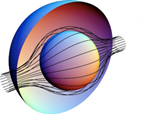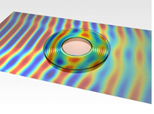Invisibility Cloaks and Other “Impossible” Optics
From Revolutionary Science to Disruptive Technology
David R. Smith
James B Duke Professor of Electrical and Computer Engineering
Director, The Center for Metamaterials and Integrated Plasmonics
Duke University
About the Lecture

In 1968, Russian physicist Victor Veselago suggested the possibility of a negative index material—a material with a negative index-of-refraction. Such a material, Veselago realized, would change everything we know about optics and electromagnetics, twisting and bending light in new ways not possible with conventional materials. But, Veselago also noted that while such materials were consistent with the laws of physics, negative index materials did not exist in any naturally occurring material or composite, and thus his suggestion was relegated to a scientific curiosity. In 2000, our group found a way to demonstrate Veselago’s conjecture using artificially structured materials, now known as metamaterials, and to experimentally confirm Veselago’s striking and counterintuitive predictions. This demonstration provoked intense interest and vigorous debate, with many questioning the very foundations of negative index. However, within a few years, not only had the controversy been settled, but metamaterials enabled many more “impossible” devices, such as the invisibility cloak demonstrated by our group in 2006. These breakthrough demonstrations proved that metamaterials can support new physics and new wave propagation behavior. Today, not only is the science forging ahead and as exciting as ever, but also there is serious effort to create commercial products and devices using metamaterials and their remarkable capabilities. This effort is launching a new industry, poised to have a disruptive impact on many technology sectors, including, to name just a few, satellite communications, collision avoidance radar and security screening. In its first decade metamaterials has become a fertile platform for realizing new physics and for building revolutionary new products. And there is much more to come!


About the Speaker

David R. Smith is the James B. Duke Distinguished Professor in the Department of Electrical and Computer Engineering at Duke University. He is also Director of the Duke Center for Metamaterial and Integrated Plasmonics. And he is the Founding Director of the Metamaterials Commercialization Center at Intellectual Ventures in Bellevue, Washington. David’s research interests include the theory, simulation and characterization of unique electromagnetic structures, including photonic crystals, metamaterials and plasmonic nanostructures. He and his colleagues demonstrated the first left-handed (negative index) metamaterial. David and his colleague John Pendry developed a new electromagnetic design approach, now termed transformation optics, and suggested the possibility that a metamaterial they designed would act as a “invisibility” cloak. David and his colleagues also subsequently demonstrated a real metamaterial “invisibility cloak”, publishing a landmark paper describing the material and demonstrating its cloaking abilities in 2006. In addition to his scientific research, David has been active in transitioning metamaterial concepts for commercialization, serving as a co-founder of Evolv Technology, Echodyne Corporation and Pivotal Commware, and as an advisor to Kymeta Corporation, all devoted to developing metamaterial products. David is an author on over 300 publications in the area of metamaterials, and more than 70 patent applications and patents. His publications have been cited so often by others in the scholarly literature that he has been named a “Citation Laureate” every year since 2009 by ISI Web of Knowledge for having among the highest number of highly cited papers in the field of Physics. Among many other honors and awards, David was part of the five-member team that received the EU’s Descartes Research Prize in 2005 for their contributions to metamaterials and other novel electromagnetic materials. He was selected as one of the “Scientific American 50” in 2006. He is a co-recipient of the American Physical Society’s McGroddy Prize for New Materials, for “the discovery of metamaterials”. And he was elected to the National Academy of Inventors in 2016. David earned his BS and PhD in physics at the University of California – San Diego.